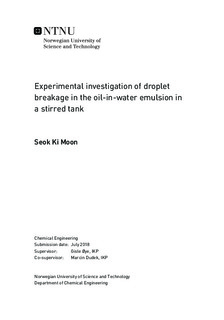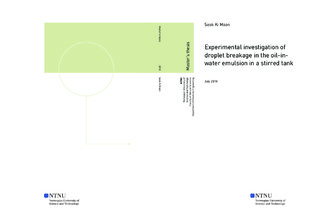| dc.description.abstract | In the modern oil and gas industry, the amount of produced water becomes major issues as its production is increased, especially in the matured field. To dispose produced water to the sea or utilize it for re-injection process, a certain level of produced water quality needs to be achieved. To achieve its quality level, it is important to separate dispersed organic compounds out of the produced water. For the efficient separation of dispersed organic compounds, the oil-in-water emulsion droplet breakage phenomena are of fundamental interest and it was experimentally investigated in this thesis.
To investigate the emulsion droplet breakage phenomena, laser diffraction method and spinning drop method were used for measuring emulsion droplet size distribution and the interfacial tension between two phases. Silicone oil 50 and 100 with three different types of surfactants were used to examine their influence on the emulsion droplet breakage. As a continuous phase, MQ water, 0.1wt\%, 3.5wt\% and 20wt\% NaCl solution were used for understanding its effect as well. The experiments were performed under the turbulent condition with purpose-built mixing tank and Rushton turbine.
Based on the experimental data, the influence of dispersed phase viscosity, different types of surfactants, salinity of continuous phase and dispersed phase volume fraction on the emulsion droplet size distribution was analyzed. Furthermore, the maximum size of the droplet in the emulsion was predicted by using Kolmogorov-Hinze theory and other advanced models in consideration with dispersed phase viscosity and the difference in mass density between the dispersed phase and the continuous phase. The comparison between the theoretical value of dv95 and dv95 values from the experiment was conducted to estimate the prediction capability of the model. | |

